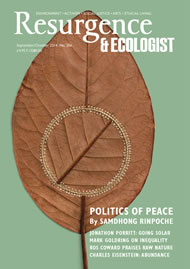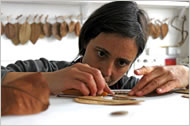As a small child in her native Germany, Susanna Bauer was taught to crochet; but she was not interested in making the usual blankets and covers, but rather in making tiny items in fine cotton thread. They mirrored the matchbox-sized world that fascinated her. She grew up in the Bavarian countryside, where she could further explore the small things that most adults simply pass by unseeing. Her acute observation and her appreciation of the miniature along with her craft skills led her into a career in model making. She made props for the film industry, for advertising and for animations. That career was largely city-based and made her restless for time to spend closer to Nature once again.
Before Bauer moved to Cornwall permanently, on her short escapes from London she began to crochet once more and to combine that work with found objects. In the most subtle of her interventions on pieces of wood she added outcrops of crochet like a dome of mould or an unusual fungus. These are easily missed by casual viewers. In other works, two leaf forms are linked by tenacious threads as if some strangely ordered spider had left an unyielding net. We are rewarded by the wondrous only if we take the time to sharpen our eyes to her world. A combination of fine craft skill, a concern for small things and collecting found objects has made up her vocabulary.
More recently, Bauer discovered magnolia leaves. Magnolias are ancient trees and some fossil forms of them may date back nearly 60 million years. They preceded bees, so they rely on beetles to pollinate them. Bauer’s primary interest has been in their leaves. She has homed-in on one particular tree and collects some of the leaves it sheds throughout the year. These fleshy leaves are robust and they have a wide range of sizes and a broad palette of colour, depending on when they fall. Some are scarred by weather or by insects. Others have their fine veins exposed but clinging to their more substantial skeletons. Bauer collects and selects them and then they people her studio awaiting further consideration for transformation.
Whether Bauer cuts and realigns, patches holes or makes three-dimensional forms from the leaves, the attuned viewer will become aware of the extraordinary nature of the acute vision and dexterous fingers that enable her to put these works together. The crochet is visible and it is stitched through leaves that must be quite brittle and prone to tearing. Bauer has become sensitive to the qualities of each leaf and to what each might allow her to add to or to manufacture with it. But the crafting is so subtle that it does not call attention primarily to itself: it always remains the means to the making of the overall work. The combinations of leaf and thread, wood and thread, thread and stone are the source of her metaphors.
Bauer seems understandably shy and unwilling to try to elucidate or decode the allusions in her work. It is as if she sees her role as making visible the invisible. If she were to try to write down meanings it would nail the work and not allow its focus to shift for each viewer. Our attention is called to something we may not have considered or begun to understand. In a very simple way, we can consider each magnolia leaf as a person. Each certainly has a personality. Each bears the scars and traces of its life and each echoes its small part of that larger body, the root and branch of the whole tree and a seasonal life in the world. Indeed, we might begin to imagine the whole world in the single leaf of a magnolia tree.
Bauer has begun to work with small branches in combination with leaves. Some of the leaves are stitched into place and others are curled into cones like lone wasps’ nests. The branches have all the vigour of sprightly, drawn lines and they are selected to dance with one another in white box frames. This gives them a curious status, as if they had been collected as specimens by an eager naturalist. This contextualisation helps viewers to focus and maybe to afford closer examination. Around her studio sit pieces of beachcombed detritus, lines of leaves queuing for her consideration, a huddle of twisting sticks and empty boxes awaiting inhabitants. It is a place where the humblest materials will find the nimblest of fingers to join them together in ways that can provoke and awaken us.
For more information on Susanna Bauer’s work, visit www.susannabauer.com








